 The electronic eye security systems available in the market are expensive, and programming is very difficult for a microcontroller based system. Here is a simple and inexpensive electronic eye security system that you can build easily.
The electronic eye security systems available in the market are expensive, and programming is very difficult for a microcontroller based system. Here is a simple and inexpensive electronic eye security system that you can build easily.
Main objective of this project is to design a security system based on a photo-sensing arrangement. It uses dual comparator LM393 that is widely used in many commercial applications. Here, it is used to sense the input signal through a light-dependent resistor (LDR). Comparator output drives a buzzer and a relay.
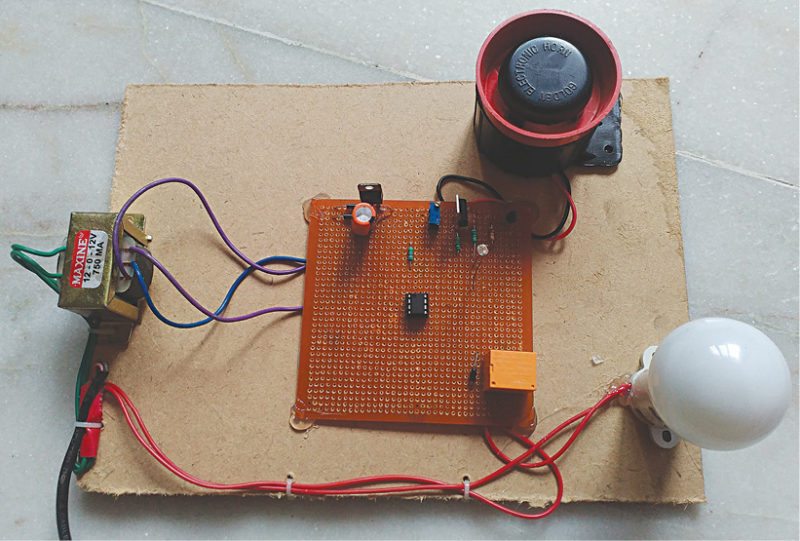
This concept is very useful as a burglar deterrent in places like banks, malls, jewellery stores, hotels and homes. Fig. 1 shows the author’s prototype.
Circuit and working of electronic eye security system
Circuit diagram for the electronic eye security system is shown in Fig. 2. It is built around 12V-0-12V, 750mA secondary transformer (X1), 1N4007 rectifier diodes (D1 through D3), LDR (LDR1), filter capacitors C1 and C2, 5V voltage regulator 7805 (IC1), dual comparator LM393 (IC2), 12V multi-tone high-gain buzzer (PZ1), transistor TIP122 (T1) for driving PZ1, transistor BC547 (T2) for driving 12V, 1C/O relay for controlling an electrical appliance or bulb (B1), and 10-kilo-ohm potmeter VR1.
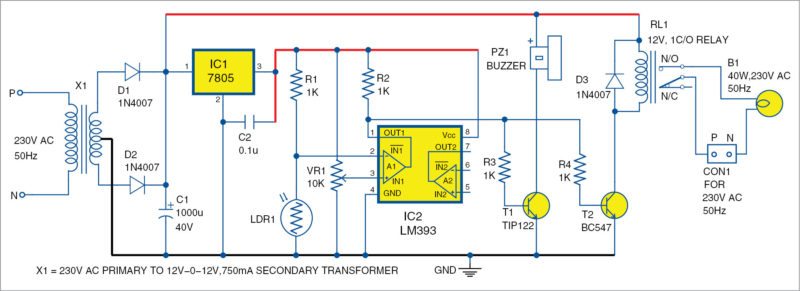
When light falls on LDR1, its resistance drastically decreases, which leads to triggering an alarm to alert the user.
This system is suitable for securing cash boxes and lockers. The circuit is placed inside the cash box or locker in such a way that, when the burglar opens it and uses a torch light to find the valuables, light falls on LDR1, which acts as an electronic eye.
Signal output from LDR1 is fed to IC2. Output from IC2 activates the alarm when light falls on LDR1 during a burglary attempt. At the same time, bulb B1 glows as a visual alert to thwart the burglary attempt.
Case 1. If reference voltage at pin 3 of IC2 is less than sensor voltage at pin 2 of IC2, output goes low automatically. This indicates that no light is falling on LDR1. Low output of IC2 is fed to T1 and T2. As a result, both are in cut-off state and so no current flows through the buzzer, keeping it in silence mode. Similarly, no current flows in the relay, and so B1 does not glow.
Case 2. If reference voltage at pin 3 of IC2 is greater than sensor voltage at pin 2 of IC2, output goes high automatically. This indicates that light is falling on LDR1. High output of IC2 is fed to T1 and T2. As a result, both transistors are in on (active) state. Current flows through the buzzer and relay. The buzzer produces a loud alarm to alert you or people around you and, at the same time, B1 glows as the circuit completes through relay RL1’s contacts.
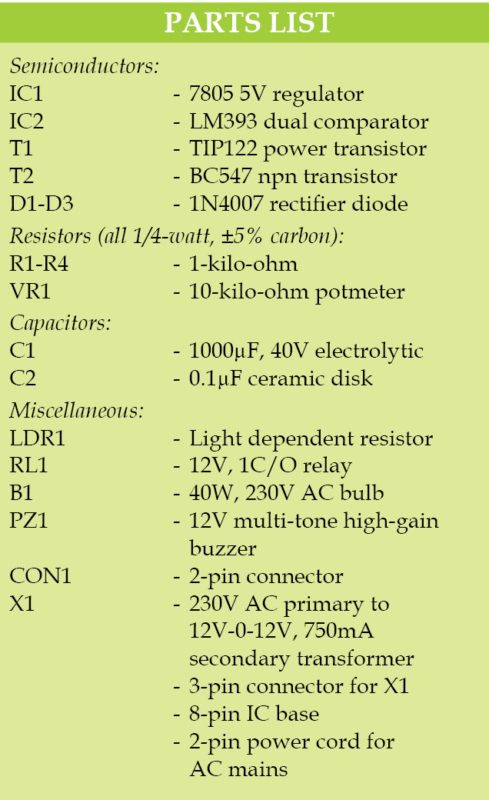
Construction and testing
An actual-size, single-side PCB for the electronic security system is shown in Fig. 3 and its component layout in Fig. 4. After assembling the circuit on the PCB, enclose it in a suitable plastic box.
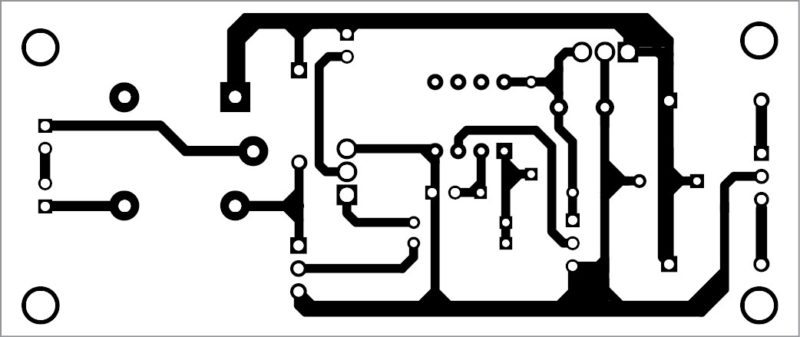
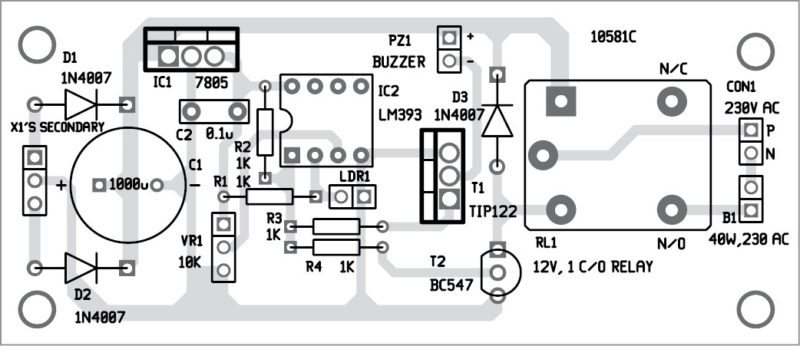
Download PCB and Component layout PDFs: click here
Pamarthi Kanakaraja is assistant professor in Usha Rama College of Engineering and Technology, Andhra Pradesh









Is this working and what is the advantage and how much it can cost
Yes, the circuit is perfectly working. The advantage is that it is an inexpensive security device working something like a surveillance system. Whenever light falls on the sensor (LDR1) in the circuit, an alarm sounds to alert the owner. This circuit costs below Rs 1000.
The size on paper is confusing. Please resize photo to original. When paste onto Microsoft Word, it is clearly larger than the actual design.
Dear Pierre, you can download PCB and component layout PDFs present at the end of the article.
i want to this circuit with components available,how to buy
Comment:
How do I access it and how much
Kindly elaborate your query.
is this working…..if yes plz give info about working nd testing of circuit
@Mr Reddy : Sorry, asked components aren’t available with us. More other project kits, visit kitsNspares.com
Can it be done on any other boards other than PCB’s?
Sir we can store data in the system?
We can keep it as door lock?
please my colleague , i want to work this project
but i want people who build this circuit
if possible he can give me his email
my email [email protected]
Excellent
Thank you for your feedback.
Thinking to do this mini project….!
Excellent work sir
small doubt life span of this project ?????
Hello sir,
I am a final year BE electronics and communication student can I present this electronic eye security system as seminar……
Yes, you can.
Hello sir,
I am final year BE student from electronics and communication stream can I give this project as seminar please do reply me as soon as possible…..
hello Sir, The buzzer in the circuit is ringing continuously as soon as the circuit is turned on. Can u please help us ??
Thank in advance..:)
Sir…can. you tell me about how much will this project will cost ???? Please give me it’s approx price……..I want to do this as my mini project …..
have you solve the problem about buzzer ????
Kindly elaborate your query.
same problem is occuring in my project,EFY can you help me???
Kindly elaborate your query.
Hello sir, can i show it as major project for btech Final Year ECE please reply
Yes, you can show this project as a final year project. You can also check other DIY projects here
The buzzer starts ringing as soon as power supply is switched on. Please help. Thanks in advance
The buzzer works Everytime the power supply goes on irrespective whether the light falls on LDR or not.Please help.
hello sir can i use this topic for diploma final year project.
what does it do LM393 Out 1K resistor ? I did not ask the transistors base.
Resistor R2 connected to LM393 is basically a pull-up resistor to drive the output transistors. If any problem, you can try replacing it with a 10-kilo-ohm resistor.
why didnt you use bridge rectifier?
Bridge rectifier produces efficient output and ripple or noise free voltage but for that you need four diodes instead of two diodes. Here, the circuit will work even if it is not a ripple free or pure DC output. You can use bridge rectifier here also, in that case you don’t need a centre-tapped transformer.